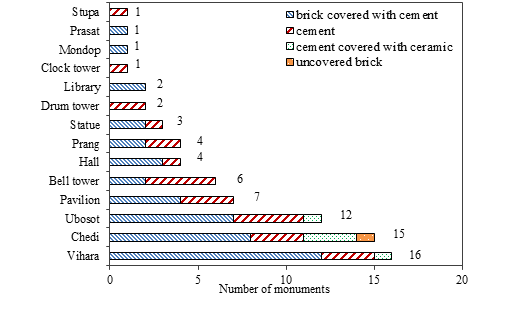A Computational Program for Estimating Atmospheric Corrosion of Monuments DOI: 10.32526/ennrj.17.3.2019.19
Main Article Content
Abstract
This study developed a novel computer program for predicting the deterioration of various types of materials from historic monuments caused by exposure to atmospheric pollution. The program was designed based on a set of materials’ dose-response functions, which take air pollutants together with climatic parameters into account. It is a web-based application that requires three input datasets: monuments’ material characteristics, local meteorological data and air pollution levels over a defined exposure time. It is also capable of estimating restoration costs. Quantification of future monument deterioration is possible by extrapolation of linear temporal relationships for air pollution and meteorological parameters. This user-friendly-interface program cooperates with Google Maps™ to find the nearest air pollution and meteorological stations to the monument site. The program may be used as a tool providing quantitative information for effective policy-making in conservation of cultural heritage monuments. To illustrate its use, the program was employed to assess the accumulated deterioration of 75 Buddhist monuments comprised of various materials located in a historical area of Bangkok, Thailand. It was estimated that the total accumulated material loss from all monuments over seven years exposure in this environment to be approximately 410 cm3 with an overall restoration cost of about 210,000 USD.
Article Details
Published articles are under the copyright of the Environment and Natural Resources Journal effective when the article is accepted for publication thus granting Environment and Natural Resources Journal all rights for the work so that both parties may be protected from the consequences of unauthorized use. Partially or totally publication of an article elsewhere is possible only after the consent from the editors.
References
2. Chitranukroh J, Buranakarn V. Sentiment in traditional Thai architecture. Nakhara: Journal of Environmental Design and Planning 2006;1(1):117-32.
3. Duan L, Yu Q, Zhang Q, Wang Z, Pan Y, Larssen T, Tang J, Mulder J. Acid deposition in Asia: emissions, deposition, and ecosystem effects. Atmospheric Environment 2016;146:55-69.
4. Grøntoft T. Conservation-restoration costs for limestone façades due to air pollution in Krakow, Poland, meeting European target values and expected climate change. Sustainable Cities and Society 2017;29:169-77.
5. Kambezidis HD, Kalliampakos G. Mapping atmospheric corrosion on materials of archaeological importance in Athens. Water, Air, and Soil Pollution 2012;223(5): 2169-80.
6. Karaca F. Mapping the corrosion impact of air pollution on the historical peninsula of Istanbul. Journal of Cultural Heritage 2013;14(2):129-37.
7. Lan TTN, Nishimura R, Tsujino Y, Satoh Y, Thi Phuong Thoa N, Yokoi M, Maeda Y. The effects of air pollution and climatic factors on atmospheric corrosion of marble under field exposure. Corrosion Science 2005;47(4):1023-38.
8. Lefèvre RA, Ionesco A. The stock of materials at risk of climate change in the facades of three cities inscribed on the UNESCO list: Paris, Venice and Rome. In: Lefèvre RA, Sabbioni C, editors. Climate Change and Cultural Heritage. Proceedings of the Revello International Workshop; 2009 May 14-16 and Strasbourg European Master-Doctorate Course, 2009 September 7-11. Bari, Italy: Edipuglia; 2010. p. 101-17.
9. Melcher M, Schreiner M. Model for Multi-Pollutant Impact and Assessment of Threshold Levels for Cultural Heritage (Results of the Exposure of Potash-Lime-Silica Glasses within Work Package 4 of the MULTI-ASSESS Project). Final report of the EU 5FP RTD Project. Vienna, Austria: Institute of Chemical Technologies and Analytics; 2004.
10. Pollution Control Department (PCD). Thailand State of Report 2015. Bangkok, Thailand: Pollution Control Department; 2015.
11. Rabl A. Air pollution and buildings: an estimation of damage costs in France. Environmental Impact Assessment Review 1999;19(4):361-85.
12. Roberge PR, Klassen RD, Haberecht PW. Atmospheric corrosivity modeling: a review. Materials and Design 2010;23(3):321-30.
13. Soylu A, Mödritscher F, Wild F, De Causmaecker P, Desmet P. Mashups by orchestration and widget‐based personal environments: key challenges, solution strategies, and an application. Program 2012;46(4): 383-428.
14. Syed S. Atmospheric corrosion of materials. Emirates Journal for Engineering Research 2005;11(1):1-24.
15. Thammavatevitee S. The restoration of valuable historical and cultural buildings. Journal of Environmental Design 2016;3(1):3-19.
16. Tidblad J, Kucera V, Samie F, Das SN, Bhamornsut C, Peng LC, So KL, Dawei Z, Lien LTH, Schollenberger H, Lungu CV, Simbi D. Exposure programme on atmospheric corrosion effects of acidifying pollutants in tropical and subtropical climates. In: Brimblecombe P, Hara H, Houle D, Novak M, editors. Acid Rain-Deposition to Recovery. Dordrecht: Springer; 2007.
17. Tidblad J, Kucera V, Ferm M, Kreislova K, Brüggerhoff S, Doytchinov S, Screpanti A, Grøntoft T, Yates T, De La Fuente D, Roots O, Lombardo T, Simon S, Faller M, Kwiatkowski L, Kobus J, Varotsos C, Tzanis C, Krage L, Schreiner M, Melcher M, Grancharov I, Karmanova N. Effects of air pollution on materials and cultural heritage: ICP materials celebrates 25 years of research. International Journal of Corrosion 2012;2012:1-16.
18. Tuchinda R, Knoblock CA, Szekely P. Building mashups by demonstration. ACM Transactions on the Web 2011;5(3):1-50.
19. Tzanis C, Varotsos C, Christodoulakis J, Tidblad J, Ferm M, Ionescu A, Lefevre RA, Theodorakopoulou K, Kreislova K. On the corrosion and soiling effects on materials by air pollution in Athens, Greece. Atmospheric Chemistry and Physics 2011;11(23): 12039-48.
20. Viitanen H, Toratti T, Makkonen L, Peuhkuri R, Ojanen T, Ruokolainen L, Räisänen J. Towards modelling of decay risk of wooden materials. European Journal of Wood and Wood Products 2010;68(3):303-13.
21. Yates T. Mechanisms of air pollution damage to brick, concrete and mortar. In: Brimblecombe P, editor. The Effects of Air Pollution on the Built Environment. New York: Springer; 2003. p. 107-32.
22. Yu J, Benatallah B, Casati F, Daniel F. Understanding mashup development. IEEE Internet Computing 2008; 12(5):44-52.

